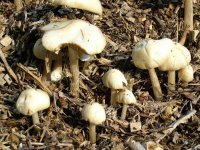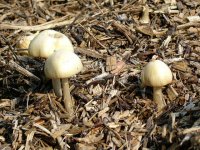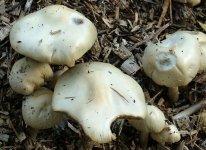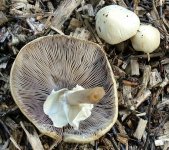Can you suggest what this species might be, please? Found growing on a pile of woodchips on the edge of mixed decidous woodland on basic soil at UEA campus, Norwich 2 weeks ago. Four photos of different stages, parts.
Thanks
David
You've posted some excellent photos which do help immensely. At first glance it looks like an Agaricus or a Pholiota species, due to the white flesh, obvious ring, and pink-brown gills. I cannot find any similar Pholiotas so I guess that leaves Agaricus.
Agaricus campestris is ruled out by the habitat. I believe that campestris means field hence the French word 'champetre' which roughly translates to bucolic. A. campestris also has a fine often rudimentary ring unlike your examples.
The cultivated mushroom, A. bisporus has a rudimentary ring, as does A. bitorquis (often seen near pavements, and very squat). So that rules those out.
Two common agarics with large apical rings are A. silvicola (Wood Mushroom) and A. arvensis (Horse Mushroom) both of which have flesh that smells of Aniseed. The Horse Mushroom is often huge and an 8" cap is not uncommon. It also has a very distinctive fleshy ring. I have never seen them in large clusters. I do not think they are Horse Mushrooms. The Wood Mushroom is smaller (~4") and they do look like your specimen, especially the large floppy ring.
So they might be Wood Mushrooms. I have never seen them on wood piles though that might be a red herring given that the lower substrate was soil. Did they smell of Aniseed? I have often seen them growing in large clusters so that matches.
The Yellow Stainer - A. xanthodermus - is possible but the ring is too large IMO. And the flesh would stain yellow fairly quickly on bruising. Quite common though.
So my guess - and it is no more than that - is Wood Mushroom. But I have to say there is something not quite right about the appearance. Mmmmm. I am pretty confident that it is not one of the other species listed above, but I might have forgotten one.







